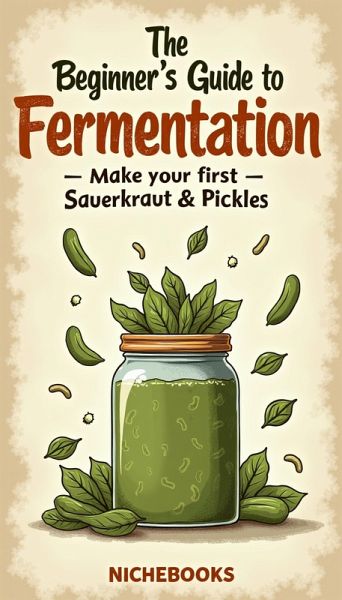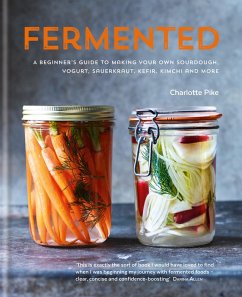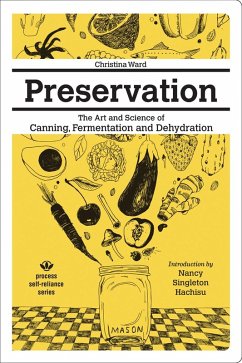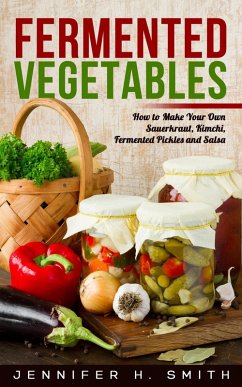
The Beginner's Guide to Fermentation: Make Your First Sauerkraut & Pickles (eBook, ePUB)

PAYBACK Punkte
0 °P sammeln!
The guide offers a comprehensive introduction to lacto-fermentation, defining it as the process of using naturally occurring lactic acid bacteria (LAB) to convert sugars into lactic acid, which preserves food, lowers the pH (into the safe 3.5-4.2 range), and creates characteristic tangy flavours. This method is simple, inexpensive, and accessible for beginners, requiring little more than fresh vegetables, a jar, and salt.Successful fermentation relies primarily on two controls: salt and creating an anaerobic environment. Salt is described as the single most important ingredient, used either vi...
The guide offers a comprehensive introduction to lacto-fermentation, defining it as the process of using naturally occurring lactic acid bacteria (LAB) to convert sugars into lactic acid, which preserves food, lowers the pH (into the safe 3.5-4.2 range), and creates characteristic tangy flavours. This method is simple, inexpensive, and accessible for beginners, requiring little more than fresh vegetables, a jar, and salt.
Successful fermentation relies primarily on two controls: salt and creating an anaerobic environment. Salt is described as the single most important ingredient, used either via the dry-salt method (e.g., 2% salt by weight for shredded cabbage) or the brine method (starting around 3% salt by water weight). Proper salting slows unwanted microbes and gives LAB a competitive advantage. Keeping vegetables fully submerged under the brine, typically using a weight, ensures the low-oxygen conditions that LAB need, minimizing the risk of mold. Most ferments thrive between 65 and 72°F (18-22°C), though cooler temperatures (60-68°F) are preferred for preserving crunch, particularly in pickles.
The guide provides recipes for common beginner projects:
• Sauerkraut: A forgiving project that teaches core skills like salting and tight packing. Key safety advice involves ensuring the cabbage stays submerged and discarding the batch if fuzzy, coloured mold appears.
• Crunchy Dill Pickles: Focuses on texture retention, often achieved through cooler fermentation temperatures, and the use of tannin-rich leaves (like grape or oak) to help maintain crispness.
• Spicy Kimchi: A more complex recipe using both salting and rinsing of cabbage, combined with a seasoning paste flavoured by gochugaru (red pepper flakes) and umami sources like fish sauce or miso.
Safety is paramount: while slight cloudiness or bubbling is normal, a thin white film is usually harmless Kahm yeast (which should be skimmed off). Conversely, fuzzy, coloured mold, rotten odors, or slimy textures are definitive signs of spoilage, requiring the entire batch to be discarded. Once the desired flavour is achieved, the ferment should be moved to the refrigerator to slow microbial activity and preserve the preferred taste and texture for long-term storage.
Successful fermentation relies primarily on two controls: salt and creating an anaerobic environment. Salt is described as the single most important ingredient, used either via the dry-salt method (e.g., 2% salt by weight for shredded cabbage) or the brine method (starting around 3% salt by water weight). Proper salting slows unwanted microbes and gives LAB a competitive advantage. Keeping vegetables fully submerged under the brine, typically using a weight, ensures the low-oxygen conditions that LAB need, minimizing the risk of mold. Most ferments thrive between 65 and 72°F (18-22°C), though cooler temperatures (60-68°F) are preferred for preserving crunch, particularly in pickles.
The guide provides recipes for common beginner projects:
• Sauerkraut: A forgiving project that teaches core skills like salting and tight packing. Key safety advice involves ensuring the cabbage stays submerged and discarding the batch if fuzzy, coloured mold appears.
• Crunchy Dill Pickles: Focuses on texture retention, often achieved through cooler fermentation temperatures, and the use of tannin-rich leaves (like grape or oak) to help maintain crispness.
• Spicy Kimchi: A more complex recipe using both salting and rinsing of cabbage, combined with a seasoning paste flavoured by gochugaru (red pepper flakes) and umami sources like fish sauce or miso.
Safety is paramount: while slight cloudiness or bubbling is normal, a thin white film is usually harmless Kahm yeast (which should be skimmed off). Conversely, fuzzy, coloured mold, rotten odors, or slimy textures are definitive signs of spoilage, requiring the entire batch to be discarded. Once the desired flavour is achieved, the ferment should be moved to the refrigerator to slow microbial activity and preserve the preferred taste and texture for long-term storage.
Dieser Download kann aus rechtlichen Gründen nur mit Rechnungsadresse in A, B, CY, CZ, D, DK, EW, E, FIN, F, GR, H, IRL, I, LT, L, LR, M, NL, PL, P, R, S, SLO, SK ausgeliefert werden.













